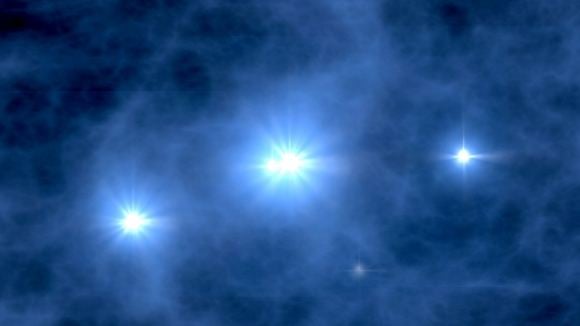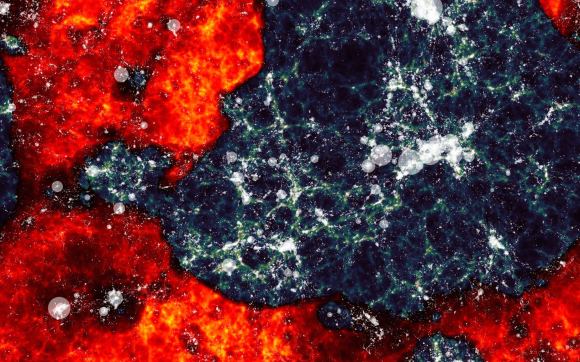How can young galaxies in the early Universe have ancient stars? That's the question a team of astronomers set out to answer using JWST as a probe. They first spotted the massive objects in 2022 and are still working to explain what these things are.
The infrared-sensitive recently JWST zeroed in on three of these objects. Interestingly, it found them emitting light from stars that appear to be mysteriously old. The galaxies themselves were seen as they appeared about 700 million years after the Big Bang. They look nothing like the spirals and ellipticals we see in the more "modern" universe.
"We have confirmed that these appear to be packed with ancient stars — hundreds of millions of years old — in a universe that is only 600-800 million years old. Remarkably, these objects hold the record for the earliest signatures of old starlight," said Bingjie Wang, a postdoctoral scholar at Penn State University and lead author on a paper describing the find. "It was totally unexpected to find old stars in a very young Universe. The standard models of cosmology and galaxy formation have been incredibly successful, yet, these luminous objects do not quite fit comfortably into those theories."
In addition to ancient stars, the data from JWST also reveal the existence of unexpectedly large supermassive black holes in the galaxies. "It's very confusing," said Joel Leja, assistant professor of astronomy and astrophysics at Penn State. "You can make this uncomfortably fit in our current model of the Universe, but only if we evoke some exotic, insanely rapid formation at the beginning of time. This is, without a doubt, the most peculiar and interesting set of objects I've seen in my career."
What Gives with Such Galaxies and Ancient Stars?
Since JWST can easily see back to extremely early epochs of cosmic time, these results reveal what the earliest objects were like. It doesn't yet explain how such old stars exist so soon after the birth of the Universe. If they truly are several hundred million years old, then they started forming extremely early in cosmic time. It's possible they were born much sooner than astronomers think. Their formation, for now, is hidden from our view. So, it's tough to know exactly when the process of star birth first began.
That's one challenge JWST's infrared abilities should help explain, particularly as astronomers use it to probe deeper into the earliest cosmic epochs. It shows objects emitting non-infrared light (UV) stretched by the expansion of the Universe into the infrared. This so-called "ancient" light streams from numerous objects, including stars, galaxies, and the active hearts of galaxies. As Wang notes, it's not clear what bits of the emitted light comes from different objects. It could be coming from early galaxies appearing unexpectedly old and more massive than our Milky Way Galaxy. If so, then they formed much earlier than astronomers suspect. It's also possible that the light comes from more normal-mass galaxies with "overmassive" black holes. Those supermassive monsters could be about a hundred to a thousand times more massive than such a galaxy would have in the "recent" Universe.
"Distinguishing between light from material falling into a black hole and light emitted from stars in these tiny, distant objects is challenging," Wang said. "That inability to tell the difference in the current dataset leaves ample room for interpretation of these intriguing objects. Honestly, it's thrilling to have so much of this mystery left to figure out."
More on those Unexpectedly Big and Early Supermassive Black Holes
If the light the JWST detects does come from regions around supermassive black holes, then you have to think about why they're so bright so early in history. Since these are luminous in infrared, it means the original emissions were in UV light. And, the brightness means there's a lot of activity going on to emit the light. That implies much more mass in the central SMBH than expected. And, according to co-author Joel Leja, it's confusing because these objects don't seem to fit existing models of the early Universe.
"Normally supermassive black holes are paired with galaxies," he said. "They grow up together and go through all their major life experiences together. But here, we have a fully formed adult black hole living inside of what should be a baby galaxy. That doesn't really make sense, because these things should grow together, or at least that's what we thought."
Need More Data about Ancient Stars and Baby Galaxies
By baby galaxies, Leja explained, these systems are only a few hundred light-years across. By contrast, our Milky Way Galaxy is about 100,000 light-years across (give or take). However, those tiny galaxies contain about the same number of stars as the Milky Way—between 10 billion and a trillion stars. "These early galaxies would be so dense with stars—stars that must have formed in a way we've never seen, under conditions we would never expect during a period in which we'd never expect to see them," he said. "And for whatever reason, the Universe stopped making objects like these after just a couple of billion years. They are unique to the early Universe."
Clearly, JWST will need to do some more looking to help explain these anomalous objects in the infant Universe. In particular, astronomers will want to know more about how ancient stars appeared so early in history. Future observations should provide a deeper, longer spectral look at all these objects. That will allow astronomers to differentiate the light from stars and the light from the regions around supermassive black holes. Each of these objects has its own specific light "fingerprint" that tells astronomers what it is. The answers they get will help them understand not only the evolution of early stars and their galaxies but also the continuing questions surrounding the origins and growth of supermassive black holes so early in cosmic time.
For More Information
Tiny Bright Objects Discovered at Dawn of Universe Baffle Scientists
RUBIES: Evolved Stellar Populations with Extended Formation Histories at z ~ 7–8 in Candidate Massive Galaxies Identified with JWST/NIRSpec
 Universe Today
Universe Today


